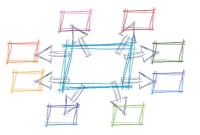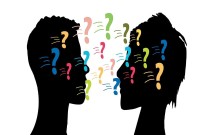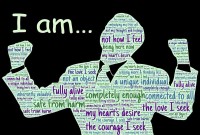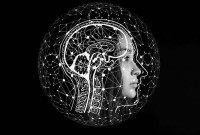- Home
- Business Processes
- Industry Knowledge
- Aerospace Industry
- Automotive Industry
- Banking Domain
- BFSI Industry
- Consumer/ FMCG Industry
- Chemicals Industry
- Engineering & Construction
- Energy Industry
- Education Domain
- Finance Domain
- Hospitality Domain
- Healthcare Industry
- Insurance Domain
- Retail Industry
- Travel and Tourism Domain
- Telecom Industry
- Leadership Skills
- eLearning
- Home
- Leadership Skills
- Communication Skills
- The Process of Communication
The Process of Communication
Communication has as its central objective the transmission of meaning. The process of communication is successful only when the receiver understands an idea as the sender intended it. How does a message or an idea travel from one person to another? To transmit our message, we engage in a sensitive and complex process of communication, with different elements like sender, message, channels, receiver, noise, and feedback.
What do we mean by a Process?
Any activity can be viewed as a thing or a process. A thing is static, time bound, and unchanging. A process is moving, continually changing, with no beginning or end. In our definition, communication is a process—something that is continually changing.
Communication as a Process
Communication is dynamic, ongoing, and ever-changing because individual words, sentences, and gestures have no meaning in isolation. They make sense only when viewed as parts of an ongoing, dynamic process. To fully understand the process of communication, we must notice how what we say and do influences and affects what the other person says and does. We must pay attention to the changes we experience and how these changes influence and affect our perception, interpretation, and interactions with others, from moment to moment, year to year, and decade to decade.
We also need to be sensitive to the ongoing changes in those we communicate with because they are changing too. Communication is alive, and to fully appreciate it requires that we view it as a dynamic, fluid, and continually changing process.
Elements of Communication
Elements of Communication that make it a continuous process are a sender, message, channel, receiver, noise, and feedback.
Sender – The Source of Communication:
The source is the originator of the message. It is the person or persons who want to communicate a message to another person or a group of people. The source of communication is the sender who has a message to impart. The sender or source may be an individual (speaking, writing, drawing, gesturing), or a communication organization (a newspaper, publishing house, television station, or a motion picture studio). The source of a message can be an individual speaker addressing a group, a child asking for candy, a couple sending out invitations to a family reunion, or a person writing a letter.
The sender provides verbal or non-verbal cues that can be received, interpreted, and responded to by the receiver. The sender may use oral, written, graphic signs, or symbols to convey the message. The communication skills, attitudes, and convictions, the knowledge of the content, objectives, the socio-cultural milieu, etc. of the sender have an impact on the effectiveness of communication.
The sender has to decide how to communicate a message, which channel is to be selected for the message, and what type of strategies should be planned so that the message makes the desired response.
Communication Message:
The message is the idea, thought, or feeling that the source wants to communicate. A message is a set of signs and symbols that are given by the source to create meanings for the receiver. Simply put, the message is the content that is shared between the participants in the communication process. Messages are made of signs or symbols and codes that are signals, which represent something. Messages may be in the form of ink on paper, sound waves in the air, impulses in an electric current, a wave of the hand, a flag in the air, or any other signal capable of being interpreted meaningfully.
It is our ability to create messages from the verbal and nonverbal dimensions of communication that truly distinguishes us from all other forms of life. Our ability to create communication not only is the most significant way humans differ from animals and plants, but it also may be one of the deepest and strongest drives within us—to express and share who we are. What more powerful and significant way to express who and what we are than by communicating our thoughts and feelings with others?
This message is encoded or converted into verbal and nonverbal symbols that will most likely be understood by the receiver. Messages are encoded and those who receive them must decode them to interpret or understand the meaning of the message. The message constitutes the core of the communication process. It needs to be formulated to suit the specific needs of the receiver and must be expressed in an intelligible way to have the desired objective. According to Wilbur Schramm, the message must fulfill certain conditions if it is to arouse the desired response in the receiver. The message must be so designed and delivered to gain the attention of the intended audience.
- The message must employ signs that refer to the experiences common to the source and the receiver, so as to get the 'meaning across.'
- The message must arouse the needs of the receiver and suggest some ways to meet these needs.
- The message must suggest a way to meet these needs which is appropriate to the context in which the receiver finds at the time when moved to make the desired response.
Communication Channel:
Channel is the medium used to communicate a message from the sender to the receiver. The channel could be spoken word, the printed word, electronic media, or even non-verbal cues such as signs, gestures, body language, facial expressions, etc. When we communicate through language or speech, we encode the message into written or spoken words. We use signs and symbols to communicate. Language in any culture contains thousands if not hundreds of thousands of words to select from and arrange in endless combinations to form the basic structures of verbal communication. There are even more subtle and not-so-subtle nonverbal (or non-language) communication behaviors that can be added to the mix.
In modern communication parlance, the word 'channel' mostly refers to mass communication media such as newspapers, radio, television, telephone, computers, the internet, etc. The selection of an appropriate channel is crucial for the success of communication.
Channel refers to the means employed to transmit or receive messages. It also refers to the five senses: seeing, touch, hearing, smell, and taste. A message is received through any of the above modes of sensory perception.
- No message can be transmitted unless they are encoded.
- Several sensory faculties are involved in the communication process.
- Communication is more effective and lasting, meaning clearer when several sensory faculties are involved in receiving meaning.
- Channel also includes mechanical devices.
- A message may be seen through print or visual media.
- It can be heard through a sound media or voice (audio), speech, musical instruments.
- It can be seen and heard as in the case of films, television, and other audiovisual media.
- Can be touched, smelt, or tasted through models, exhibits, specimens and experiments.
- The deaf and mute are taught to follow the sign language.
- In order to communicate messages to a distance, we use sound waves.
- In order to make them last, we use writing.
- In order to complete the act of communication, the message must be decoded. Decoding is the process of making sense out of the message received.
The receiver of Communication:
After selecting the words, sentences, and nonverbal cues to form the thought or feeling we are attempting to communicate, we send the message to the recipient, who processes the message and gives a response in the form of feedback. The receiver is the recipient of the message. The receiver also called a destination, maybe an individual or a group, a crowd, or a mob, reading, listening, or watching. The receiver is the object in the communication process. Communication cannot take place without a receiver for whom the message is meant. We receive a message, interpret it, and derive meaning from it. The receiver can be an individual or a group of people.
The sender must constantly keep the needs, aspirations, knowledge, socio-cultural milieu, and background of the receiver if the message is to have the desired objective. To make the message effective, the sender has to understand the nature and profile of the receiver of the message, needs and expectations, and possible response to the message. This is important in both face-to-face as well as mediated situations. The recipient’s role in the communication process is also a creative process because what he or she selectively perceives and interprets from the original message will determine the meaning of the message for him or her.
Once the receiver hears the words and receives the nonverbal cues from the sender, she must interpret or decode them if communication is to occur. The receiver must decipher the language and behaviors sent by the source so they will have meaning. The receiver should receive the message in the same way it was meant by the sender. The message recipient then creates a response from all the words and nonverbal behaviors available. Receiving and creating a response is just as important as creating and sending the original message.
Noise in Communication Process:
Noise is distortion in a message which affects the flow of communication. The noise could be due to internal as well as external sources. Noise creates barriers in communication and it could be of many types. There are various types of noises which have implication in the process of communication and how these can be overcome for facilitating effective communication are discussed in the next section.
Communication Feedback:
The response given by the receiver to the message of the sender is known as feedback. Communication is a two-way process, without the element of feedback any discussion on the process of communication is incomplete. You have read in sub-section I.3.2 that interpersonal common allows greater scope for feedback as both sender and receiver can decipher the facial expressions, body movements, and cross-question each other to remove their doubts/queries. In fact, their roles are intertwined and cannot be distinguished. The element of feedback gets gradually diluted when the number of participants in communication activity increases.
Perhaps the greatest contribution of cybernetics to the communication process has been that of feedback. Feedback not only makes communication circular but also enables modification possible at different stages in the process of communication.
Related Links
You May Also Like
-
Narrative leadership is interpreted as the leader who aspires to construct leadership by telling stories. Leadership is a task of persuasion, of winning people’s minds and hearts. Storytelling is thus inherently suited for the task of leadership. Learn about the narrative leadership style and how to use this style to inspire and motivate followers or to manage change.
-
In the field of communication studies, there are numerous models. No one model is suitable for all purposes and all levels of analysis. Some common models are known as Lasswell Model, George Gerbner Model, David Berlo Model, Shanon and Weaver Model, Osgoods Model, and Schramm Model. All these describe the four components of the communication process, namely, the source (communicator), the message, the channel, the receiver (audience).
-
Storming Stage of Team Development
Storming is the second stage of team development and this stage is characterized by a bid for power and inter-personal conflicts. Learn the key factors that occur in the storming stage and the strategies that a team leader can adopt to pass this stage of high winds
-
A manager or an employee in an organization who is experiencing a high level of stress may develop high blood pressure, ulcers, irritability, difficulty in making routine decisions, loss of appetite, accident proneness, and the like. These can be subsumed under three general categories, physiological, psychological, and behavioral symptoms. Stress can give rise to a number of changes.
-
Communication is defined as the process of meaningful interaction between two or more persons with a view to arriving at a common meaning and understanding. There are different types of communication and these are used on different occasions. In this section on communication skills, Technofunc will equip you with the skills most needed in today’s dynamic, demanding workplace.
-
This style is characterized by leaders making decisions for others and expecting followers to follow instructions. The directive leader is adept at giving instructions, setting expectations, and establishing timelines and performance standards. However, it is possible for the same leaders to display both directive and supportive behavior as per the demands of the situation.
-
Listening is the foundation for good communication. It is also the hardest skill to master. Do you listen to confirm what you already know, or do you listen to explore and learn new things? How can we create receptive communication as a listener? The real art of listening involves awareness and sensitivity to the feelings of the speaker because it is at the feeling level that genuine connection, relationship, and healing occurs.
-
At different points in your professional career, it is helpful to identify your core values. Values are the qualities considered to be the most important guiding principles that determine the priorities in your life and greatly influence your career choices. Your career brings happiness when it is in agreement with the beliefs you have about what is important and meaningful to you. Awareness of your values will help you develop a clearer sense of what's most important to you in life.
-
Narcissistic leadership is a leadership style in which the leader is only interested in him. Narcissists are good for companies that need people with vision and the courage to take them in new directions. Such leaders sometime might be highly successful, but is it a style to be followed. Learn the various types of narcissistic leadership and the characteristics of such leaders.
-
Have you ever noticed how we express ourselves or interact with each other? Have you ever wondered what communication is and what role it plays in our lives? One may wonder if communication is so omnipresent and integral to our lives, why study communication at all? We need to study communication because it is a complex process that consists of many elements and is also beset with a number of barriers and there is a need to remove the barriers so that the communication process is effective.
Explore Our Free Training Articles or
Sign Up to Start With Our eLearning Courses

About Us
Learning
© 2023 TechnoFunc, All Rights Reserved










